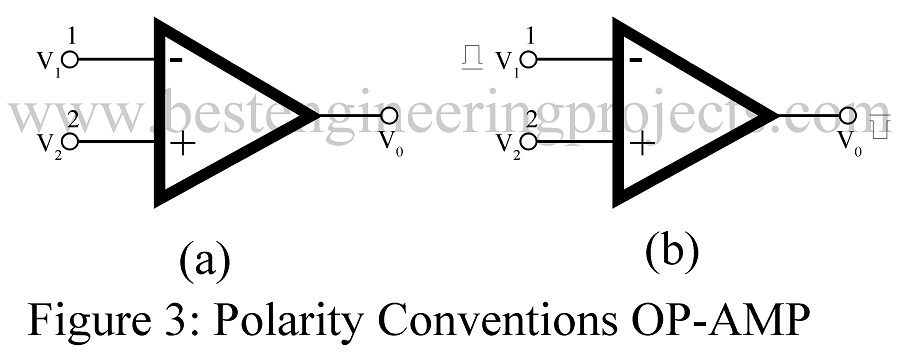What is an OP-AMP? An operation amplifier (Op-Amp) is basically a multistage, high gain (Av>105) direct-coupled amplifier with two differential inputs and a single-ended output and which uses feedback to control its overall response characteristics.
It may be used to perform numerous linear operations and some nonlinear operations. An important feature of the operational amplifier is that by simply changing the feedback impedance, its operation may be altered. A modern Op-Amp uses integrated circuit technology. The IC Op Amps are widely used as versatile, predictable, accurate, and economical system building blocks. They possess all the merits of monolithic ICs.
Many analog circuits, both linear and nonlinear, are constructed using IC Op-Amp as the basic building block. This IC Op-Amp, along with a few external discrete components may be used for the following linear analog systems:
- analogs computers
- voltage-to-current converters
- current-to-voltage converters
- amplifier for various specific rises such as dc instrumentation, tuned amplifier, video amplifier, etc.
Op Amps may also be used in nonlinear analog systems such as
- amplitude modulators
- logarithmic amplifiers
- anti-logarithmic amplifier
- analog multipliers
- sample-and-hold circuits
- comparators
- square wave generators
- triangular wave generators etc.
Block Diagram of Operational Amplifier
The block diagram of the operational amplifier is shown in figure 1.
Input Stage:
- Increases the CMRR.
- The high gain requirement is adjusted.
- Most of the gain is adjusted.
- Provides the input impedance very high.
Intermediate Stage:
- Driven by the output of 1st
- Adjust the half gain of 1st
- The error voltage is canceled in this stage.
Level Shifting:
- Suppress the dc level down to zero volts with respect to ground
- Consisting of current amplifiers as emitter followers.
- Also minimizes the error by suppressing dc level to the ground.
Output Stage:
- This stage increases the output voltage swing and the current in supplying capability of the amplifiers.
- Provides low output impedance.
OP-AMP Symbol | Symbol of Operational Amplifier
The standard triangular symbol for an OP-AMP is shown in Figure 2(a) through the one shown in figure 2(b) is also used often. In figure 2(b), the common ground line has been omitted. It also does not show other necessary connections such as for dc power and feedback etc.
The OP-AMP’s input can be single-ended or double-ended (or differential input) depending on whether the input voltage is applied to one input terminal only or to both. Similarly, the amplifier’s output can also be either single-ended or double-ended. The most common configuration is two input terminals and a single output.
Polarity Convention of Op-amp:
In figure 2(b), the input terminals have been marked with minus (-) and plus (+) signs. These are meant to indicate the inverting and non-inverting terminals only (figure 3). It simply means that a signal applied at the negative input terminal will appear amplified but phase-inverted at the output terminal as shown in figure 3(b). Similarly, the signal applied at the positive input terminal will appear amplified and in phase at the output. Obviously, these plus and minus polarities indicate phase reversal only.
It does not mean that voltage v1 and v2 in Figure 3(a) are negative and positive respectively. Additionally, it also does not imply that a positive input voltage has to be connected to the plus-marked non-inverting terminal 2 and negative input voltage to the negative-marked inverting terminal 1. In fact, the amplifier can be used either way up so to speak. It may also be noted that all input and output voltages are referred to a common reference usually the ground shown in figure 2(a).
Characteristics of Ideal Operational Amplifiers
An ideal op-amp would exhibit the following electrical characteristics:
- Open-loop Voltage Gain A0 is infinity.
- Infinity input resistance Ri so that almost any signal source can be driven it and there is no loading of the preceding stage.
- Zero output resistance R0 so that the output can be driven by an infinite number of other devices.
- Perfect Balance, i.e. the differential voltage in inverting and non-inverting terminals be zero.
- Zero output voltage when input is zero.
- Infinity bandwidth so that any frequency signal from 0 to ∞ Hz can be amplified without attenuation.
- Infinity common-mode rejection ratio so that the output common-mode noise voltage is zero.
- Infinity slew rate so that output voltage changes occur simultaneously with input voltage changes.
- Zero drift of characteristics with temperature.
Characteristic of Practical Op-amp
There are practical op-amps that can be made to approximate some of these characteristics using a negative feedback arrangement. In practice, the input resistance, output resistance, and bandwidth can be brought close to ideal values by this method.
The practical op-amp has the following characteristics:
- The open-loop voltage gain A0 is maximum and finite, a typical value for practical op-amp is considered to be 200,000.
- The input impedance Zi is maximum and is finite i.e. in the order of 100k or more.
- The output impedance Z0 is minimum, not zero, in the order of 100 or less.
- The CMRR is maximum and finite.
- Bandwidth is maximum and finite i.e. it can amplify dc to 1 MHz signal.
- The slight drift of characteristics due to the change in temperature is not null.
- Two terminals may be virtually ground not Vd = 0 exactly, for all conditions.
- Maximum slow-rate and has the finite value.
- Output is negligible due to dc-bias when the input is zero.
While there are a variety of op-amps, each with specific inner design features such as internal frequency compensation, FET inputs, Darlington inputs, current sources as active loads, input voltage and output current limiters, and many others, the analysis of a specific op-amp equivalent circuit will provide a good basis for understanding the inner operation and construction of the op-amp and aid in selecting a proper op-amp for the desired application.


